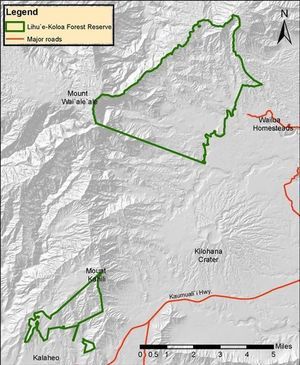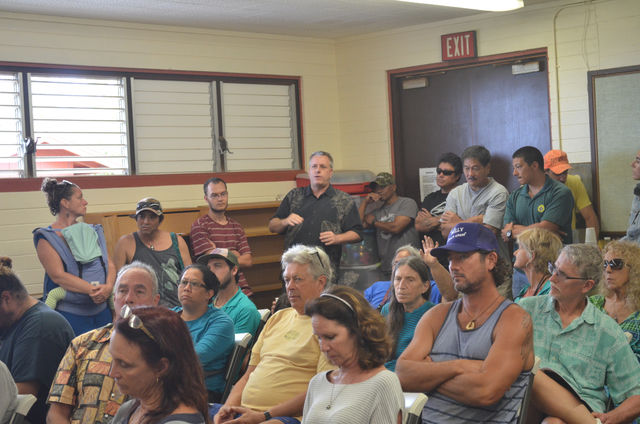KAPAA — The majority of the crowd at Saturday’s Wailua-Kapaa Neighborhood Association meeting wanted one thing: for the state to take down the bridge currently under construction over Keahua Stream. “Can we just have a show of hands for the
KAPAA — The majority of the crowd at Saturday’s Wailua-Kapaa Neighborhood Association meeting wanted one thing: for the state to take down the bridge currently under construction over Keahua Stream.
“Can we just have a show of hands for the people here, how many would support finding a way to take down that bridge?” asked Erik Burton, from the island’s Eastside.
Over half of the about 70 people in attendance raised their hands.
The bridge in question is a $2.7 million single-span, steel truss, 20-ton, 115-foot-long vehicle bridge with an adjacent pedestrian path. It’s set to be finished in May.
Construction began on the bridge in September without a public meeting, triggering outcry among those with concerns about the project’s transparency, as well as how it will affect tourist traffic and recreation.
“The bridge was built for safety reasons and it’s taken years for the monies to be found to do this,” said Sheri Mann, Kauai branch manager for the Department of Land and Natural Resources’ Division of Forestry and Wildlife.
While the original plan was to continue building bridges spanning the three crossings the road makes through Keahua Stream, Mann said there are no plans to construct more bridges over the other fords or to further repair the road.
“There hasn’t been the number of incidents at the other fords. We don’t have any (building) plans on any other fords,” she said. “Institutionally, it’s known through DOFAW that this ford is a problem.”
But community members say building a bridge over the first crossing is simply opening up access for those who are unprepared to drive further and then get stuck, requiring Kauai’s rescue crews to intervene.
Concerns also revolved around the sacredness of the place to local residents and the use of the ford for swimming and play.
“It’s the only good place for little ones to swim,” said Bryna Storch, mother of a 2-year-old daughter who lives on Olohena Road.
Burton said he thinks it “clogs up the swimming hole” as well.
“It’s ugly and it destroys the resource,” he said of the bridge.
And some people think it’s possible that the bridge is just step one for opening up the Lihue-Koloa Forest Reserve for commercial logging and eventually for drilling into Mount Waialeale, the island’s source of water.
Mann said on Saturday that she doesn’t know enough about the water issues on Kauai to address the questions about water diversion and any potential plans for drilling on the mountain, but she said the construction of the bridge is not connected to a proposed state plan to allow logging.
“That project doesn’t have anything to do with the Keahua Bridge and many of you don’t believe that, but it doesn’t,” Mann said at the meeting. “If logs or wood products come out, they have to go another way. The bridge was built for safety reasons.”
Currently DLNR/DOFAW is considering an update to the Lihue-Koloa Forest Reserve Management Plan that would allow for the harvesting of 360 acres of timber plantations in the forest reserve, made up of three species of non-native eucalyptus and paperbark trees.
The trees were planted in the 1930s and again in the 1960s when the Keahua Arboretum started as a demonstration project for exotic timber species.
Also under consideration is the removal of invasive albizia trees.
Updating the management plan, which Mann said usually happens every 5 to 15 years anyway, is just the first step. An environmental assessment and several public meetings would be required before action could be taken.
“We’re very early in the process and we may never cut any trees,” Mann said. “What we’re doing here is telling the public we’re considering and do you have any general concerns about it? Let us know.”
Mann said when it comes to the type of wood or wood production potential in the area, “all options are on the table,” and DLNR is exploring all of them.
But she promised the audience that Kauai’s residents will be kept in the loop with the process.
“So with this environmental assessment, there’s a 30- day comment period,” said Rayne Regush, president of Wailua-Kapaa Neighborhood Association. “Would it be possible to get an extension on the comment period, say 90 days, so we have a chance to look at the EA?”
Mann answered the question with a resounding yes — she will give the public extra time to comment on the document before it goes to the Office of Environmental Quality Control.
“You have my word I’ll get it out before it goes to the OEQC. I’ll do whatever it takes,” she said.
Deadline to comment on the state’s draft environmental assessment for the update to the Lihue-Koloa Forest Reserve Management Plan is March 30.
The current 2010 management plan can be viewed at: http://dlnr.hawaii.gov/forestry/frs/reserves/kauai/lihue-koloa/.
Comments can be sent to Phillip LaHaela Walter at Philipp.LaHaelaWalter@hawaii.gov or to mitchell@anden.consulting.




